|

original art by Amanda Walsh
The unicorn stands alone, still as frost. It keeps watch down the corridors of time. The past and the future meet in the presence of the unicorn; the darkness and light become one. Patient as a candle flame, inviolate, here is our guardian, keeper of the silent unknown.
--Josephine Bradley--
 (In Pursuit Of The Unicorn) (In Pursuit Of The Unicorn)


Chinese Unicorns
Unicorns have been with us, in one form or another, since the dawn of history. It's believed they were first described by the Chinese as a miraculous creature called the Ch'i lin (or K'i lin), a "great unicorn," that radiated exquisite colors, had a voice like a thousand wind chimes, avoided fighting at all costs, lived for a thousand years, and had a horn twelve feet long. It was said that Ch'i lin walked so softly its hooves made no sound. Some believed this was because it was so soft-hearted it did not want to crush the blades of grass beneath its feet.
Ch'i lin was very special to the Chinese. It was a creature of great power and wisdom, and would show itself at special times. Its appearance was always considered a sign of good fortune. When a ruler was just and kind and the times peaceful and prosperous, the unicorn would appear in a glade. It would also appear when a great leader was about to die or be born.
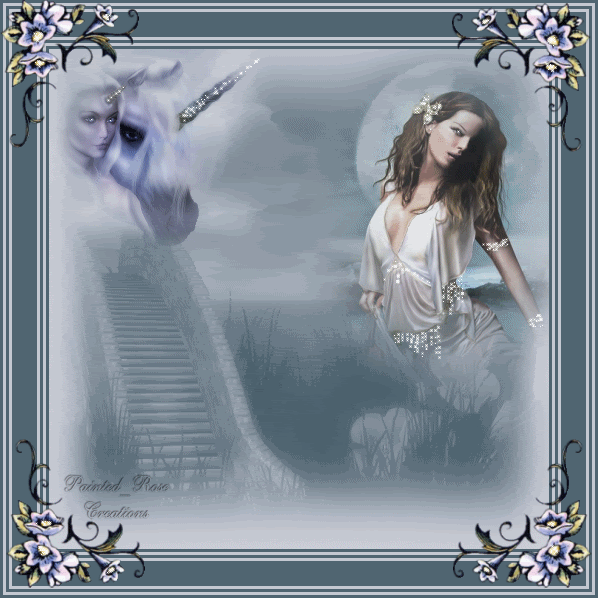
The earliest recorded appearance of the Ch'i lin was to a legendary Chinese sovereign called Fu Hsi c. 2900 BC. As the story is told, Fu Hsi was sitting on the bank of the Yellow River one day near the end of his life. He was thinking about mortality and trying to think of a way he could record his thoughts for following generations (writing had not yet been invented). Suddenly a Ch'i lin rose out of the river and came toward him. On its back it carried certain magical sigils from which Fu Hsi was able to devise the first written Chinese language. Over time the script has evolved so naturally that today's readers of modern Chinese are still able to understand something written 2,000 years ago.
The signs which had inspired Fu Hsi are called the Pa Kua, or eight trigrams. They are a symbolic combination of broken and unbroken lines and form the basis not only for Chinese writing, but also for the philosophic and divinatory systems known as the I Ching, or Book of Changes. Fu Hsi is one of four men given credit for authoring this work, along with King Wen, the Duke of Chou and Confucius. Fu Hsi was followed as sovereign by Shen-nung and then by Huang Ti, who was also known as the Yellow Emperor or the August Sovereign. He became one of the most revered of all Chinese rulers. There is a record in the Bamboo Books of the appearance of a Ch'i lin at his palace in 2697 BC, shortly before his death. The Ch'i lin walked silently, majestically into the palace, roamed its halls and vanished. The unicorn carried in the middle of its forehead a long, straight, tapered and helically grooved ivory horn. During the reigns of the following four Emperors, in what is considered China's Golden Age of peace, justice and good government, the Ch'i lin often appeared as a mark of approval.
The most famous example of the appearance of a Ch'i lin foretelling the birth of a great leader happened over 2,500 years ago when it came to a young woman named Yen Chen-tsai. She and her husband had no son and though she prayed constantly, her prayers went unanswered. After a long time, she decided to make a pilgrimage to a holy shrine in the mountains. As she was traveling to the shrine, a Ch'i lin appeared, knelt before her and dropped into her hand a tiny jade tablet from its mouth. On one side was a message which said:
"The son of the essence of water shall succeed to the withering Chou and he will become a throneless king."
Months later Yen Chen-tsai ("the essence of water") bore a son called Kung Fu Tse, better known as the great Chinese sage, Confucius. Confucius never wore a crown or commended men. But, through his teachings, Confucius probably did as much to shape China as the power of many kings and warlords combined. Seventy years later, while writing his Spring and Autumn Annals, it is said that Confucius was told by one of his disciples that a strange beast had been killed nearby by a party of noblemen. They had been out hunting and surprised the beast by setting fire to the underbrush. Some witnesses said the creature ran into a chariot and was killed by accident, others said the hunters were too quick with their spears. Whatever the truth of the incident, the animal had been killed and its body abandoned at a crossroads. Confucius left with his disciple to see this animal for himself. He immediately recognized the creature and cried: "It is a Ch'i lin. The Ch'i lin, benevolent beast, appears and dies. My Tao is exhausted." Confucius ended his Annals prematurely with an account of the incident and is then said to have laid down his pen and never written another word. However, that may not be exactly the case as the following poem is attributed to Confucius and it appears it was written after seeing the Ch'i lin:
In the age of Tang and Yu the Unicorn
and the Phoenix walked abroad.
Now when it is not their time they come
And what do they seek?
The Unicorn, the Unicorn, my heart is sad.
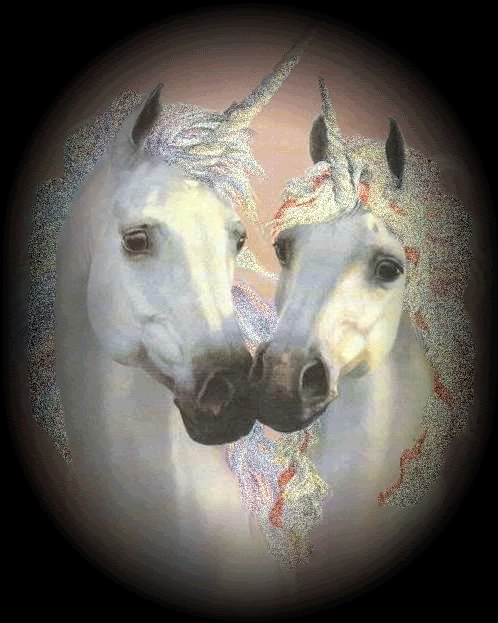
art by Barrie Tinkler:
http://www.tinkler-art.com/
By the time of the Middle Ages, most people in China were familiar with the unicorn. When sailors aboard the Chinese Emperor's jewel ship arrived in East Africa in 1415, they were told stories about the horned creature they knew as the Ch'i lin. They were very surprised since Africa and China are totally different and they did not expect this animal to be known there.
The Africans described the animal as having the body of a deer, a long neck and a single horn. It was gentle, graceful, rarely spoke or made noises and was said to be 18 feet tall. According to the reports, it would hide among the mimosa. The Chinese crew was able to capture one of these creatures and returned with it to China. There was much excitement in the Emperor's Court when it was reported they were bringing home a Ch'i lin. As it turned out, the Somali word for the animal was girin, which had confused the expedition's leader. In fact, the African "unicorn" turned out to be the giraffe!
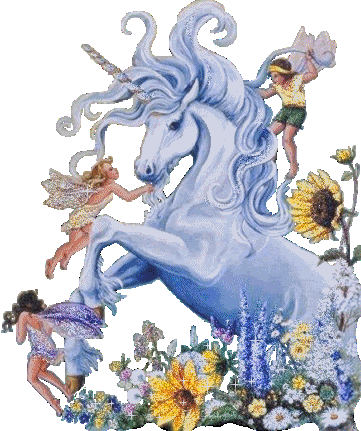
The Four Sacred Beasts: The Chinese Unicorn
There is an ancient Chinese myth which explains the creation of the universe. In the beginning, the universe was merely an egg. Heaven and earth were not separate. The stars and the planets were one. But when the egg of the universe cracked, Chaos spilled out. Heaven and earth separated and the stars and planets split.
Into this chaos came P'an Ku, the first god/human. It took him 18,000 years to create the present universe and earth. He was assisted in this work of creation by the four most fortunate animals--the dragon, the phoenix, the tortoise and the unicorn. When P'an Ku's work was completed, he died. The dragon swan into the seas. The tortoise crawled into the swampy wetlands. The phoenix rose into the sky and flew to the open lands. The unicorn galloped into the green forests. These four sacred animals became the guardians of the hidden realms upon the earth and those places beyond, where their strength is undiminished by contact with humans.
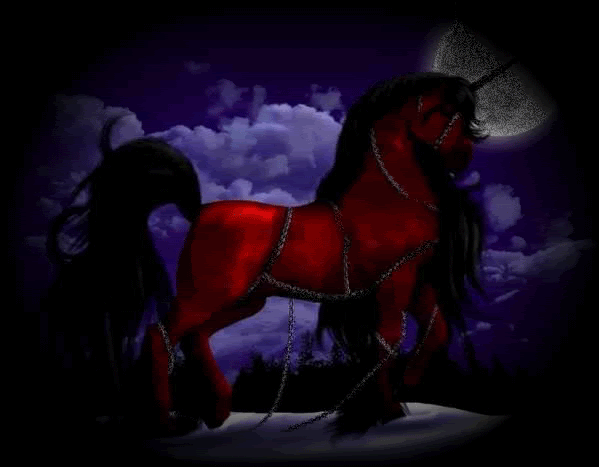
art by Amanda Walsh
In heraldry, a unicorn is depicted as a horse with a goat's cloven hooves and beard, a lion's tail, and a slender, spiral horn on its forehead. Whether because it was an emblem of the Incarnation or of the fearsome animal passions of raw nature, the unicorn was not widely used in early heraldry, but became popular from the fifteenth century. Though sometimes shown collared, which may perhaps be taken in some cases as an indication that it has been tamed or tempered, it is more usually shown collared with a broken chain attached, showing that it has broken free from its bondage and cannot be taken again.
It is probably best known from the royal arms of Scotland and the United Kingdom: two unicorns support the Scottish arms; a lion and a unicorn support the UK arms. The arms of the Society of Apothecaries in London has two golden unicorn supporters.
Since the rhinoceros is the only land animal to possess a single horn, it has often been supposed that the unicorn legend originated from encounters between Europeans and rhinoceroses. The Woolly Rhinoceros would have been quite familiar to Ice-Age people, or the legend may have been based on the surviving rhinoceroses of Africa. Europeans and West Asians have visited Sub-Saharan Africa for as long as we have records.
The Roman Empire also imported rhinoceroses for their arena 'games', along with hippopotamuses and other exotic creatures. Roman crowds could distinguish between the African and Indian rhinoceroses, both of which were slaughtered in front of huge crowds.
Chinese from the time of the Han Dynasty had also visited East Africa, which may account for their odd legends of 'one-horned ogres'. The Ming-dynasty voyages of Zheng He brought back giraffes, which were identified by the Chinese with another creature from their own legends.

Unicorns and Warriors
Unicorns have been connected with three famous warriors Julius Caesar, Alexander the Great, and Genghis Khan.
Julius Caesar
In his account of the conquest of Gaul, Caesar wrote about various strange creatures said to inhabit the Hercynian Forest in Germany. Included among these was "An ox shaped like a stag from the middle of whose forehead, between the ears, stands forth a single horn, taller and straighter than the horns we know."
Alexander the Great
It is said that Alexander rode a Karkadann the famous Bucephalus, described as having the body of a horse and the head of a lion. This was a creature Alexander had first encountered when he was about 13 years old. It had been presented for sale to his father, King Philip of Macedonia. However, it lashed out so furiously at every attempt to mount it that Philip's champion riders soon gave up. The animal was about to be led away as totally useless and intractable. But Alexander protested, claiming he could ride it. His father, thinking to teach him a little humility, allowed Alexander to try on the condition that if he failed, he would have to pay the entire cost of the beast (13 talents). And he told Alexander that if he succeeded in taming it, he would give it to him as a gift. Alexander was able to tame the unicorn by approaching it as an animal who could only be ridden with its own consent, not a horse whose will needed to be broken. It is said that after Alexander successfully rode the unicorn, the king shed tears of joy and pride and said to Alexander: "Oh my son, look out for a kingdom equal and worthy of you, for Macedonia is too small to contain you."
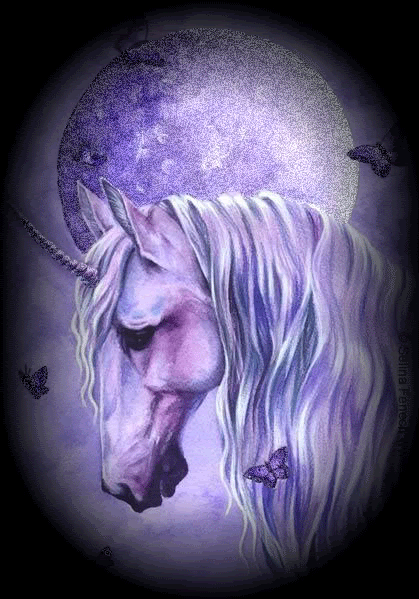
art by Selina Fenech:
http://www.selinafenech.com/
Many think Bucephalus was only a horse, but others claim he was actually a Karkadann or unicorn. Reportedly, Alexander spoke softly to him, stroked him and leaned against him. The Karkadann was fearless against demons and allowed Alexander to tame griffins. Bucephalus remained with Alexander almost to the end of both their lives and was ridden by him into every major battle during his conquest of Egypt and the Persian Empire. Legend and history agree that Bucephalus died during Alexander's last great battle with King Porus of India. Only the cause of his death is disputed, whether it was from wounds, old age or simple exhaustion. His death marked a change in Alexander's fortunes--his legendary luck deserted him and his character, which had already begun to show signs of instability, took a rapid turn for the worse. He won the battle against King Porus, but only barely. His army refused to go any further and Alexander was forced to turn back. He decided to explore the coast along the way, leading to thousands of his troops perishing as they crossed the Makran Desert in what is now southern Pakistan. The number of soldiers who died during this trek has been estimated at 80,000.
While Alexander faced all hardships on equal terms with his men, the high death toll undermined his support. Back home in the heart of his Persian Empire, Alexander first began working on restoring order. He then started planning an expedition to circle Africa to the gates of the Mediterranean Sea. According to the Royal Diaries, following a celebratory banquet, Alexander became ill with some type of fever. It didn't seem all that serious at first, but after twelve days of steady deterioration, he died at the young age of 32. The exact cause of his death is still a mystery; some believe he may even have been murdered. After all his exploits and risks, it was a rather ignoble death for the man who'd conquered so much of the known world during his lifetime.
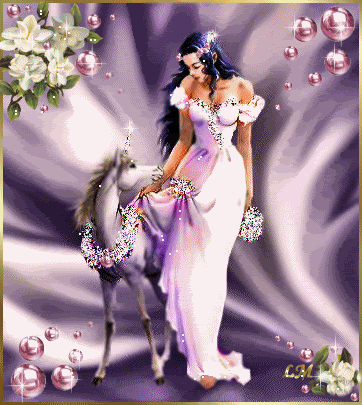
Genghis Khan
Genghis Khan was one of the most powerful rulers of China. He acquired an empire which stretched from Korea to Persia. His father was especially important in his life. Kahn's quest for power grew even stronger after his father's death. Many believe Kahn was trying to fulfill a promise he made to his father. Before each battle, he would ask for his father's guidance in the task ahead. In 1224, Kahn's army marched toward India. No one was able to stop him as his armies conquered town after town and marched over mountain after mountain, moving ever closer to his next great victory. Finally they reached the last mountain - he was ready to conquer India. Kahn arose before sunrise and climbed to the top of the mountain to plan for the coming battle. When he reached the top, he stopped in amazement. There was no army to meet his. There were no soldiers at all. Then from behind a large boulder stepped a strange beast. It was small, about the size of a young deer, green, and it had a single horn of red and black protruding from its forehead. Kahn stood motionless in amazement. What did this mean? He recognized this beast. It was the Ch'i lin, the unicorn of whom he had heard many legends and tales. The Ch'i lin walked slowly and silently toward him and stopped in front of him, its eyes locked on Khan's. Then the unicorn knelt three times at Khan's feet in a sign of reverence. The air began to shimmer and a strange fragrance enveloped Khan--a scent he had not experienced in a very long time. And for the first time in his life, Khan felt fear. As Khan looked into the unicorn's eyes, they began to change. Then a strange familiar feeling crept over him. It was a feeling Khan had felt when his father was alive. As he looked at the unicorn, he realized the eyes of his father were gazing at him from the unicorn's eyes. Khan was truly afraid now because it had been nearly 50 years since his father's death. Then he heard his father's voice in his head, as clear as if his father was standing right next to him. In the distance Khan could faintly hear the sounds of his army as they grew restless waiting for the signal to attack. Still he did not move. Then the air grew clear and still around him, the fragrance he'd always associated with his father faded and the eyes of the unicorn were its own again. Slowly Khan turned away from the unicorn and looked down upon his army gathered below. A hush fell over them as they waited for Khan to speak. He briefly closed his eyes, and then spoke loud and clear, his voice touching every ear. "Turn back!" he said. "My father has warned me not to go on." Turning his back on his army, he looked once more upon the strange creature before him and tears filled his eyes. The unicorn lifted its head and was gone. India had been saved from almost certain conquest by the miraculous intervention of a unicorn!

art by Sue Dawe:
http://home.simplyweb.net/suedawe/
The Hunt of the Unicorn The Most Famous Unicorn Image
About the year 1500, a magnificent series of large tapestries was made in Belgium to trace the history of a hunt for the Unicorn. They were bought by John D. Rockefeller in 1922 and are now on display at the Cloisters museum in New York.
The series of seven tapestries follows the hunt from beginning to end. The Unicorn is discovered and chased by the party of noblemen, but they are unable to capture it. In the fifth tapestry, a young maiden tames and captures the Unicorn - relying on the age-old custom that a Unicorn could only be captured by a virgin.
In the last tapestry, the Unicorn is chained to a tree within a round wooden fence. This final scene is the most famous Unicorn image and has become the universally accepted picture of a Western Unicorn.
information by:
http://www.crystalinks.com/unicorns.html
  
background and graphics by:





|